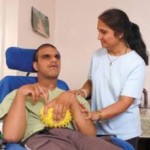
This Australian paper draws its data from two detailed observational studies of quality of life outcomes for people with ‘severe intellectual disability’ who live in group homes. The term severe intellectual disability is more frequently described in the UK as profound and multiple learning disability (PMLD).
The article sets out its three aims as:
- Using a quality of life framework to compare resident outcomes and staff practices in seven group homes.
- Exploring whether the outcomes and staff practices were consistent across all domains and all staff in these homes.
- Developing a set of qualitative indicators and examples that help to translate existing concepts into concrete examples of expected good practice for the (PMLD) group.
Group homes are described as small 24hr staffed ordinary houses for four to six people. The report acknowledges that this type of group home is currently a key component of service delivery in both Australia and the UK and are likely to remain so for the foreseeable future. A total of seven homes which fit these criteria are assessed in this work. Four of these were considered to be the best of their type and the remaining three considered to be underperforming.
The report draws heavily on the work of the UK’s late Jim Mansell who most famously contributed to the Valuing People and Valuing People Now. Mansell’s suggestion that people with more profound disabilities consistently have poorer outcomes than those with milder levels of disability is a key driver for this piece of work. Additionally, the report highlight’s Mansell’s assertion that observational methods are critical for measuring the lived experience of people with severe and profound levels of intellectual disability.

The authors highlight Mansell’s assertion that observational methods are critical for measuring the lived experience of people with severe and profound levels of intellectual disability.
Methods
The report uses 8 quality of life domains suggested by a 2002 paper (Schalock et al 2002) as the framework against which to assess the service’s performance. The paper suggests that these domains are agreed by international consensus. They are:
- Social Inclusion
- Interpersonal relationships
- Personal Development
- Physical Well Being
- Emotional Well Being
- Material Well Being
- Self Determination
- Rights
The selection of the seven care homes relates to two samples used in previously conducted observational studies focusing on behaviour, values and interactions. These are referred to as ‘Making Life Good’ and ‘Ordinary Life’. The studies took place in each house over an extended period of 9-12 months. The visits took place at a range of times throughout the day with an average of 22 visits, averaging three hrs per visit to the Ordinary Life houses and 12 visits of an average 6 hrs duration to the Making Life Good homes.
The report sets out sets of statements for each of the 8 life domains which would describe positive outcome indicators and relevant staff practices for people in these areas. These include, for example, in the Emotional Well being section: ‘People appear content with their environment, their activities, and their support; they smile and/or take part relatively willingly in a range of activities (including interaction) when given the right support to do so.’

Statements for the 8 life domains describe positive outcome indicators and relevant staff practices.
In order to create a comparison between the eight care homes the report sets out a numerical four point scale by which to evaluate the data and grade performance in each domain. The scale uses the following descriptors:
0. outcome was not present for any residents
1. mixed outcome – partial or strong outcomes for some residents some of the time
2. partially good outcome for all residents most of the time
3. strong outcome for some of all of the residents most of the time.
Results
The results showed a clear discrepancy between the homes.
- Ordinary Life scored between 14 and 22 out of a possible of 24 points with no zeros in any area. The Making Life Good homes scored between 6 and 8 points with between some 0’s at each service.
- No service managed to score the maximum 3 points in the personal development area which looks at engagement and involvement in an expanding range of activities. This seems to be caused by the issue of not all of the staff following the active support model even where this was the expressed philosophy of the home and implemented by some of the staff. Interestingly, no service scored 0 is this area.
- Emotional well being, interpersonal relations, self determination and rights were also poor scoring areas for 4 of the 7 homes. These four scored either of 0 or 1 for each of these categories. This was the key area of differentiation between the homes with the remaining 3 homes performing well.
- Physical well being was the universal area of strength in the study, with an average of 2.41 being scored.
Conclusions
The report draws the conclusion that traditional judgements made about the quality of services by organisations, staff and others based on snapshot experiences cannot be relied upon to understand service performance. “Only when values and intentions are operationalized is it possible to put them into practice”.
Crucially the report identifies the plethora of literature which describes the poor staff practices but there is almost none which describe good practice for people with PMLD. The point is also made that where they do exist, they are likely to be based on anecdote rather than a systematic approach as seen in these studies.
Strengths and Limitations
It is hard to truly evaluate the methodology used to create the quantitive analysis of the outcomes as the detailed notes drawn upon cannot be seen. It is natural to worry that subjective analysis both at the observation stage and in the later review of the written notes is likely to lead to inequalities in the scoring mechanisms. This is an issue for any judgements of this type and safeguards are in place with two authors scoring independently and then discussing their ratings. A 3rd moderating author reviewed a précis of the notes to confirm the rating.
The value of this paper does not lie however in this comparison of the two groups of homes but rather in the explanations of how the scoring was arrived at and detailed examples of the notes taken during observation. There are 4-8 examples given for each of the described areas in some level of detail. These really put the flesh on the bones of the analysis and offer some real insight to the way that Support Workers, view their role and the resulting impact that this has on the lives of the people we support.
Summary
There is no doubt in my mind that the contents of this study contain potentially, vital analysis for all staff and managers working with people with PMLD. The exemplars and narrative description contained in the results for each domain are both thought provoking and compelling. The attitudes of the staff team and the resultant impacts for the supported people are vivid and instantly recognisable from experience.

The traditional approach to professional boundaries, worker-client and without physical touch, can, and does, lead to poorer outcomes in the domains of interpersonal relationships and emotional well being.
We are also posed some significant dilemmas, for example, it is pointed out that the traditional approach to professional boundaries, worker-client and without physical touch, can, and does, lead to poorer outcomes for this group of supported people in the domains of interpersonal relationships and emotional well being. This kind of policy and staffing approach may need to be adapted.
The academic nature of this report does not lend itself to operating as a guide or handbook and the referenced ‘guide to visiting’ based on the study is disappointing. This incredibly valuable work is crying out to be translated into easily usable material for staff and managers.
One simple point we must take away is the need that our internal assessment tools follow a similar range and depth of observation displayed in these studies to truly understand outcomes for people we are supporting in group homes.
Link
Identifying Good Group Homes: Qualitative Indicators Using a Quality of Life Framework, Christine Bigby, Marie Knox, Julie Beadle-Brown, and Emma Bould in Intellectual and Developmental Disabilities, 52, 5, 348–366 [abstract]
Reference
Robert L. Schalock, Ivan Brown, Roy Brown, Robert A. Cummins, David Felce, Leena Matikka, Kenneth D. Keith, and Trevor Parmenter (2002) Conceptualization, Measurement, and Application of Quality of Life for Persons With Intellectual Disabilities: Report of an International Panel of Experts. Mental Retardation: 40, 6, 457-470. [abstract]

RT @LearningDisElf: Judgements about learning disability services quality based on snapshot experiences were not sufficient to unders… ht…
Jonathan Beebee liked this on Facebook.
Quality of life & active support for PMLD http://t.co/pS6r8OOZ8G < Great blog today from @NickBurton01
RT @LearningDisElf Quality of life & active support for PMLD http://t.co/L884MConF5 < Great blog today from @NickBurton01
Judgements about learning disability services quality based on snapshot experiences were not sufficient to… http://t.co/mzy1nA2ht5
Don’t miss: Quality of life outcomes for people with profound & multiple learning disability who live in group homes http://t.co/pS6r8OOZ8G
MT @LearningDisElf: Quality of life outcomes for people with profound & multiple learning disability in group homes http://t.co/ExX7BbkrtW
Judgements about learning disability services quality based on snapshot not… http://t.co/R2qJYphASi @LearningDisElf http://t.co/y94ImfyArl